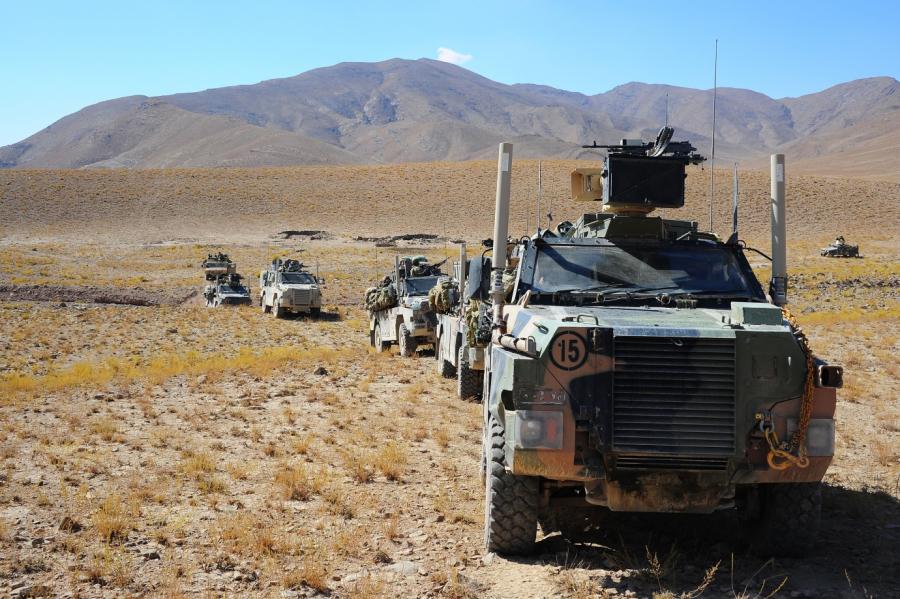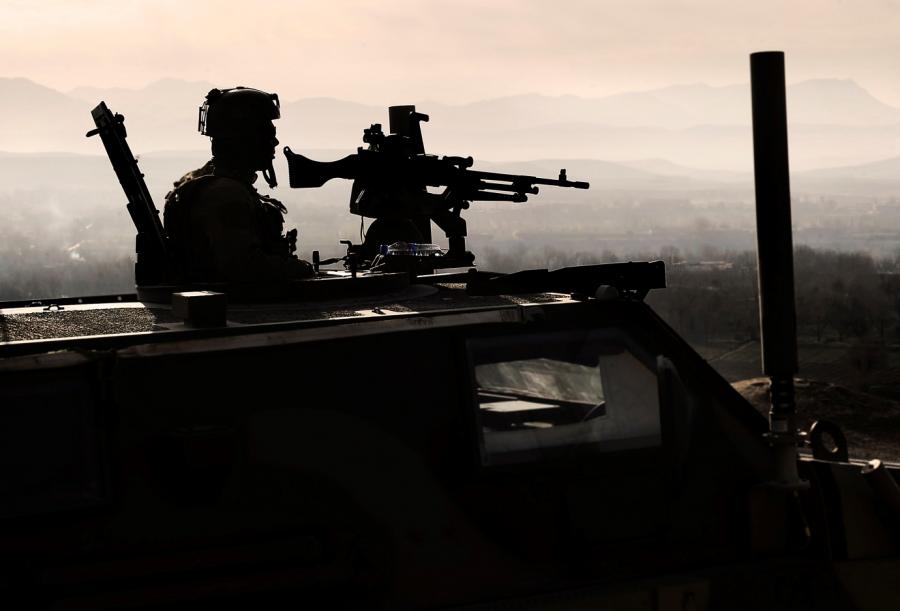Debbie - A lot more than a truck
Dear AWM,
I am writing to enquire about a rumour I’ve heard about a Bushmaster Protected Mobility Vehicle that may be displayed at the Australian War Memorial. I am a veteran and was a passenger in a PMV that was struck during MTF-5’s deployment in 2012. Is there an IED damaged Bushmaster on display? If so, it was struck around the front right of the vehicle and has ‘Debbie’ written on it, does that match? I’d like to see Debbie again if possible. Regards Daniel Snigg.
And so began research into the story behind one of the Memorial’s key objects from the war in Afghanistan.

Photographer CPL Hamish Paterson (Image courtesy of Department of Defence)
Debbie, more formally known as Echo 21 Alpha, struck an Improvised Explosive Device (IED) in Afghanistan’s Deh Rawud district in mid-2012. At the time of the blast, Private Daniel Snigg was seated in the back.
The blast happened on Tuesday afternoon, 10 July 2012. Seated opposite Snigg was Private Mitchell Smith (Mitch); crew commander Kurt Bebbington (Bebbs) was standing at the hatch and Sapper Rowan Jamieson (Jamo) was seated behind the driver. In the front passenger seat was Anak Windyana (Windy), with Private Mathew Clarke (Clarkey) driving the vehicle.
All six crew survived the blast, though two were seriously injured.
The Australian designed and built Bushmaster helped many soldiers survive such IED strikes in Afghanistan and Iraq. Key to the Bushmaster’s capability was the V-shaped hull, which could deflect blasts from mines and IEDs. The V-shape was originally conceived by the Dutch, and used on their protected vehicles in southern Africa from the 1960s to 1980s. Australian peacekeepers in places such as Namibia during the 1980s saw the protection provided by the Dutch vehicles. The peacekeepers’ advocacy of the hull would later inform the design of the Australian Bushmaster.
Although the V-shaped hull was considered innovative, it took a while for the Australians to come to appreciate the Bushmaster. Commandos were used to the situational awareness that was a feature of their distinctive long range patrol vehicles (LRPV’s), whereas the Bushmaster “seemed very big and put us in a box or a cage where we couldn’t really react to situations. We thought: what’s this massive thing? I’m not going in that – everyone will shoot at it.”
The first Bushmasters were deployed to Iraq and Afghanistan in mid-2005. The 1000th arrived in Afghanistan in late 2015. The Bushmaster’s reputation grew as it came to be seen as the key reason why so many Australian soldiers survived IED blasts.
IEDs are cheap to make, easy to set up and very effective when detonated. They can be made from recycled ordnance or homemade explosives and can be fired using pressure plates, mobile phones or something as common as the remote that opens a garage door. A typical bomb housing is a 20-litre yellow palm oil container (YPOC), as was the case with the device Debbie struck. The recovery team concluded that the bomb was a multi stacked, high grade homemade explosive (HME), most likely initiated by an Italian-made TC-6 anti-tank mine, which were known to be used in Afghanistan.
Drivers appeared to be the primary target of IEDs, and so explosions typically happened on the right-hand side of the vehicle. This was the case with Debbie. The Bushmaster’s front right wheel triggered the IED, so all the force of the blast was directly under the driver, Private Mathew Clarke. He suffered serious leg injuries, with about 14 broken bones:
First thing I remember was two big flashes of white light. The back door had blown out and dust was flooding inside the vehicle. I did a check: how’s my back, can I move? I can, good. I looked down and saw my right foot shaking uncontrollably. My left foot was at a bad angle. I was given a Green Whistle [methoxyflurane] to self-administer pain relief.
Throughout the days preceding the blast, Australian soldiers at Forward Operating Base (FOB) Qarib had been under constant fire from Taliban snipers on a neighbouring mountain. The distance between Qarib and the mountain was 1800 metres; the sniper rifles the Australians were using had a range of 1600 metres. The 50 calibre machine-guns mounted to the Bushmasters also fell short. Supplies including a Barrett sniper rifle and mortars were available at FOB Hadrian, roughly 10 kilometres away. To collect the Barrett and other essentials, a resupply trip was arranged for Tuesday 10 July.

20120618adf8248214_068 Photographer CPL Hamish Paterson
Image courtesy Department of Defence
The resupply convoy included three Bushmasters, scheduled to make a same-day return trip. Over the previous week, the Australians had travelled between the two bases a number of times. Travel time was roughly two hours each way. Although the Bushmaster’s 300-horsepower Caterpillar engine provided power and speed, travel was slow between Qarib and Hadrian. The terrain between the two bases was arid, with a lot of soft sand. Pace slowed further with searches for IEDs. On the trip out to Hadrian, Sapper Mitchell Smith was the lead searcher. The convoy crossed the Tiri River at a dry riverbed crossing on the outskirts of the green zone near Eshaqzi, about halfway between the two bases. An advantage of this crossing was its proximity to a manned police checkpoint, about 500 metres away.
They arrived at Hadrian around lunchtime, collected the Barrett sniper rifle, mortars, cigarettes and water. The convoy set off back to Qarib, with Debbie in the lead. They followed the same route home. Although this was unusual, the manned checkpoint was considered a deterrent for insurgents, since it would be too difficult to plant explosives unobserved. For the same reason, the convoy also travelled home without the routine search for IEDs.
Search engineers Rowan Jamieson and Mitchell Smith took the opportunity to catch up on sleep. After an hour or so the convoy reached the river bed crossing near Eshaqzi.
It was there that Debbie hit the IED.

Jamieson was briefly knocked out. “When I woke up, dust was everywhere, Bebbington was on the floor, head at my feet. I unclipped him, started first aid. I called, ‘Pop the red smoke!’”
Red smoke signals casualties, green smoke signals no injuries. Daniel Snigg, sitting at the back of the Bushmaster, threw the smoke grenade, signalling the crew behind to call-in the incident. The contents of the Bushmaster’s storage bins were strewn everywhere, making it difficult for Snigg to work the metal detector. “The rear access step was sheared off; I had to jump down out of the Bushmaster to try and detect the ground for any more metal.”
Mathew Clarke and Kurt Bebbington were casevaced within 40 minutes of the IED blast. They were transported by Black Hawk helicopter to the Role II Medical Facility at Tarin Kot. The rest of Debbie’s crew, and the two undamaged vehicles and their crews, remained overnight to guard the damaged Bushmaster until the Weapons Intelligence Team (WIT) arrived.
Bebbington recalls, “I always blamed myself for what happened but years later I met one of the WIT guys who worked on the investigation and it turns out we were just unlucky, because there seemed to be a trend in that area over the years before and it was likely that the IED was buried long before we hit it.”

20111226adf8106603_006 Photographer: L.S. Andrew Dakin
Image courtesy of Department of Defence
The Australian War Memorial acquired Debbie in 2013. On the front right of the vehicle, you can see the name Debbie. It is hand painted, quite faded, and is the remains of the full moniker, Debbie Does Dallas. There is a long tradition of crews nicknaming their Bushmasters. In 2010 Lieutenant Colonel Jason Blain was the commander of Mentoring Task Force 1. Of the Bushmaster, Blain says:
You build up a culture of the vehicle being part of the section. The vehicle becomes the 11th “man”, along with the driver, the commander and eight soldiers. That means it’s given all the love and attention it needs to do its job. It’s owned by one group, which is responsible for its maintenance. Some people might call it a truck, but it provided me with a lot more capability than a truck.
Mathew Clarke, Debbie’s driver, wrote to the Memorial in 2013:
I was part of the 3RAR Brigade deployed to Afghanistan in June 2012. As you can imagine I was very surprised when your story about the IED-damaged Bushmaster was brought to my attention, as I was the driver of the vehicle when it struck the IED. I am writing to enquire whether this vehicle will be on permanent display. I am very eager to see the vehicle as I was returned to Australia within days after the incident.
In 2014 Clarke visited the AWM. He had a private tour of the Memorial’s repository at Mitchell, where Debbie is stored. As he climbed out of the vehicle, Clarke remarked that at last he had completed the 2012 resupply mission.
Tracey Langner